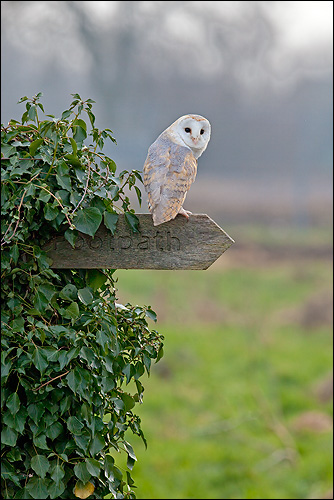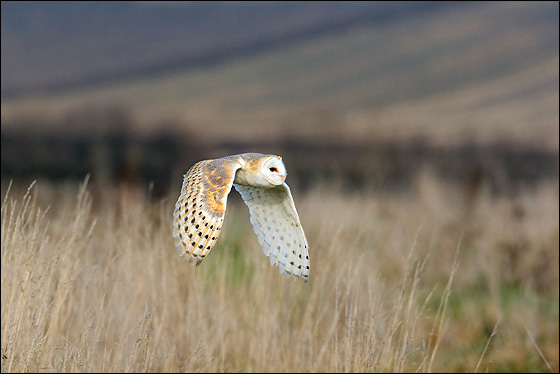Alpine Chough (Pyrrhocorax graculus)
The Barn Owl is one of the owls that is an active hunter, meaning that it obtains most of its prey while on the move. Typically it flies low over the ground, the optimum foraging height being 3 m, moving slowly forward with wavering flight and deep wing-beats, listening for movement below. Once it hears something it may hover above the disturbance first, and then strike with its feet. Not surprisingly this sort of hunting is ruined by extraneous noise, making hunting in wind and rain difficult. The wings of the Barn Owl are also specially modified to make flight as quiet as possible: the main flight feathers have a downy surface, the leading edges of the wings have comb-like fringes and the trailing edge has a hair-like fringe to reduce turbulence.
Over most of its range the Barn Owl feeds primarily on small mammals, with the proportion of these reaching 90% or more. It has been recorded eating a bewildering range of other items, though, as well, including dozens of species of birds, rabbits, moles, weasels, grass snakes, slow worms, frogs, fish, insects and earthworms. It is particularly keen on rats and mice, and in some parts of the world Barn Owls have replaced the domestic cat as the primary controller of these rodents.
It is almost as adaptable in its choice of habitat and nest site. Basically requiring rough grassland over which to hunt, the Barn Owl will occur in many such open areas, especially where these abut hedgerows, rivers or ditches along which it is easy to hunt for the abundant rodents that live there. The density of Barn Owls is restricted by the availability of nest sites, meaning that, in certain places the birds have to be quite flexible in their choice. Cavities in man-made structures such as old building and, of course, barns are particularly favoured, but hollows in trees and cliff faces may also be used, along with more unusual sites such as burrows in the ground and the abandoned nests of large birds.
A very unusual feature of Barn Owl breeding behaviour, one very rarely seen in birds, is that the male is the choosing sex, having the final say in whether the pair is formed. Normally the female assesses a male on the basis of looks, display performance, song or territory quality (and who knows what else?), but in the Barn Owl the assessment is his. Apparently he often makes it on the basis of the female’s degree of black spottiness on the female’s lower flanks, which is individually variable. If a female is well spotted her offspring will have superiorly symmetrical wing feathers, fewer external parasites and a higher degree of immunity to infection that the offspring of poorly spotted females.
In good years a pair of Barn Owls may have two broods. The offspring may remain local after they have fledged, but a significant proportion of first year birds disperse in random directions for great distances – 1600 km has been recorded. This trait has no doubt helped the Barn Owl to become one of the world’s most widely distributed birds, occurring on every continent except Antarctica, and on many isolated islands.


